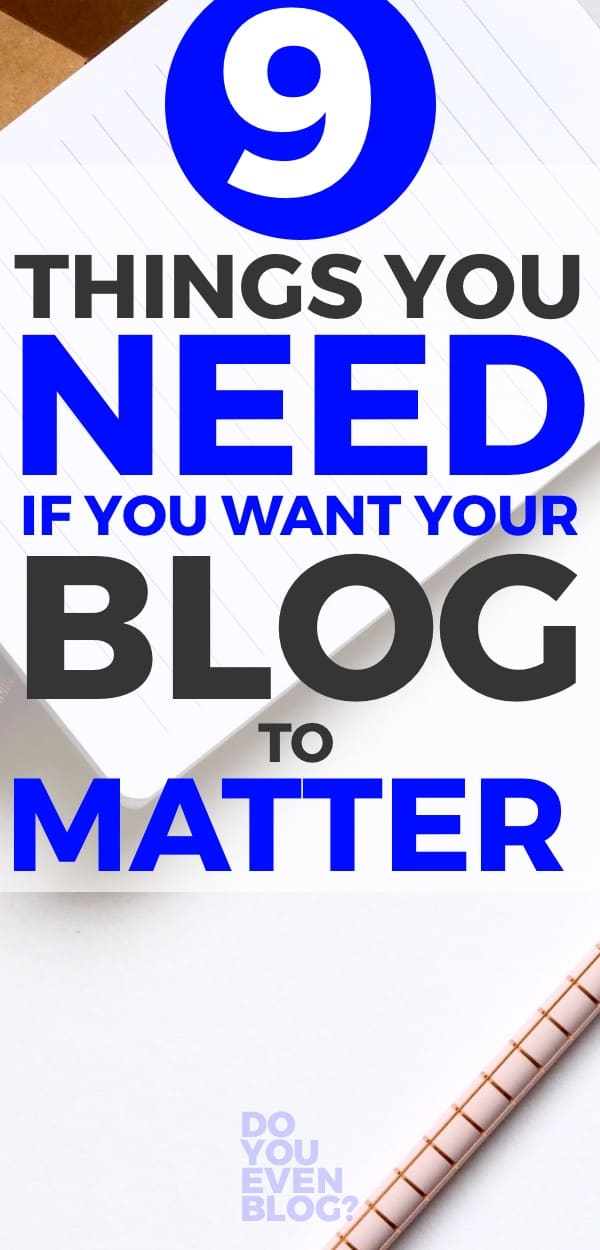Tribe! Want a few SOLID tips for creating quality content and making sure your blog MATTERS to people? Today we’re sharing a guest post from Mike from Ninja Budgeter! I love this post 🙂 Enjoy!
Hi, my name is Mike and I’m a serial entrepreneur.
Not a serial entrepreneur in the same way as Elon Musk or Richard Branson – I wish! Unfortunately I’m the kind who is easily discouraged and even more easily distracted.
…SQUIRREL!
For seven years I was a dump-truck driver, and I absolutely hated it.
If you’re wondering what it’s like to drive a dump truck, go to your mailbox, look inside and then walk back to your house. Do that over and over for eight straight hours.
It was the most boring thing I’ve ever done.
In an effort to escape the trucking life, I have started more online businesses over the years. I have never shared them all before, but here’s a peek into what I’ve tried:
- A dropshipping blog that I paid $250 to start – resulting in zero sales (this was before I knew anything about online business)
- A blog dedicated to student pilots
- An affiliate site about vacuums (I sincerely wish I were kidding about this one…)
- A travel blog
- A Seinfeld-ish site about absolutely nothing – just my musings
All of these sites taught me a few things. First off, I have an incredibly patient wife. Second, I love to write and third, online business is really, really hard.
For years my comfort zone was in a dimly-lit corner of the internet; a place where I could make mistakes, and few people would notice or care.
Swimming with the big fish…
Everything I knew about blogging changed when I started my personal finance site last year.
It’s a different game when you’re in a mainstream niche. Overnight, my competitors went from no-name bloggers half-heartedly producing ‘meh’ level content, to the likes of Bobby Hoyt, Michelle Schroeder-Gardener, the Frugalwoods and dozens of other amazing, established bloggers.
I’m in deep water now, swimming with big fish.
I’ve learned some things since then about how to make my blog matter, how to build an audience and how to create content that really helps the people I want to reach.
What Makes A Successful Blog
Do you ever wonder why some blogs succeed and others fail?
Often when that question is asked, bloggers chant in unison: “quality content”.
What if I told you there there are thousands of bloggers out there pouring their hearts and souls into amazing quality content that nobody will ever find? There is much more to blogging than producing quality content.
I have found blogs on Blogger.com that are incredibly high-quality. Unfortunately, few of their potential readers will ever find them.
The truth is, the internet is bursting at the seams with high quality content. It is literally all over the place. When it comes to blogging, high quality content is no longer a distinguishing characteristic, it is absolutely necessary.
If you can’t produce high-quality content, you can’t blog. Period.
This is especially true if you’re planning on blogging in a crowded space (ahem…Personal Finance and Blogging). There are already thousands of articles ranking on every topic imaginable. Getting noticed in such a crowded space is tough.
There are however, some fundamentals that you need to get right if you want your blog to grow, thrive and make the internet a better place.
Related reading: Starting a Blog: The Complete DYEB Blueprint (for 2018)
The 7 Things You Need To Do If You Want Your Blog To Matter
Write A Business or Blog Plan
If you ever plan to make any money from your site, you’re are not starting a blog, you’re starting a business. Ask anybody who has started a business and they will tell you that you need a plan.

It doesn’t need to be long or complicated, but it should include these things.
- What you will be offering your potential readers and/or customers
- How much you plan to invest in your business and how you will invest it
- A plan for your site design and layout
- Target customer / Avatar
- A list of your top competitors
- A list of your top potential collaborators
- Where your target customers spend their time
- How you plan to market your target audience
Figure out who you want to reach and why
Create your ideal reader, and write content for that person. Get granular here. Some questions you should answer are:
- How old is your ideal reader
- Are they married?
- Do they have children?
- How much money do they make?
- What are their interests?
- What other websites do they visit?
The more specific you can be here the better chance you have of reaching the exact type of reader that you want to.
It’s a good idea to be fluid on this point. I have found that the people who read Ninja Budgeter are not necessarily the people who I thought would read when I started.
Make Real Connections With Actual People
This should probably be first, because in my opinion, it’s the most important thing you can do while growing your blog.
Connecting with real people (i.e. making friends online) is the quickest way to grow your presence. I have made a point to connect with people on Twitter. I respond to their questions, retweet their posts and engage with them whenever I can.
Guess what? Those same people are the ones who retweet my stuff to their followers. At the moment I spend most of my time on Twitter but the same is true for Pinterest, Facebook and other social platforms. The key is to connect with the real people behind the profiles.
Every good opportunity that has come my way in blogging has been a result of reaching out to other bloggers and making a connection. This includes several guest posts and being featured on three podcasts in the last three months.
Be Selfless In Your Promotion Of Others
In my opinion, this is one of the best things that a new blogger can do to get themselves on the map. Connect with some bloggers that you like, and promote the crap out of them every chance you get.
Why? Because you’re building up relationships. The more you promote others, the more they will want to promote your stuff when you ask them, and often if you don’t.
I like to find newer bloggers that don’t have much of a following, and make a point to reach out to them personally. This can be on Twitter, commenting on their blog, sharing their stuff on a Facebook group or repinning something.
The point is that it doesn’t cost you anything to promote others and believe me – people notice.
It will be worth it the first time an A-list blogger retweets something of yours.
Write Content That Needs To Be Written
(Pete here. I friggin love this point)
Like most of us, I tend to get caught up in writing content that I think is important. It may be important to me, but does my audience care?
Every time somebody asks you a question, make a note of it. Try to find trends in your blog comments. Because you’ve figured out who your customers are, you can go to other blogs that they’re likely reading and see what content is doing well.
These are all great ways to find out what your readers (or potential readers) actually want.
I have half-assed dozens of articles in my time, and I can promise you this: nobody will ever care about what you’re doing if you don’t care about it enough to make it amazing.
Remember that if your blog is a business, your business needs to serve your readers.
Here is a fantastic guide to creating amazing content.
Use A Simple, Easy To Navigate Site Design
You don’t need a fancy site to start a blog. If you happen to be a designer, great, have at ‘er. For the rest of us, keep it simple. Too many elements can appear crowded and amateur if not done by a professional designer.
A simple design is timeless, and it’s hard to screw up.
Not to mention, it’s how many of the pros do it. Check out the design of this blog. It’s clean and simple. And Pete’s in good company.
Some of the most popular blogs on the web are built using a simple design. Don’t believe me? Check out Seth Godin, The Minimalists or Zen Habits.
Be Willing To Invest Money Into Your Site
Here’s the deal – as you get serious about blogging, you’re going to need some proper blogging tools. Email, social, plugins, etc. There are literally thousands of tools to help you step up your blogging game.
When you’re first starting up, you’ll probably be good with free versions of some tools. As your site and your needs grow however, you are going to need to invest in some tools.
Below are the tools that I use and recommend:
Social
- Buffer – For scheduling social media posts.
- TweetDeck – For scheduling Tweets only.
- Buzzsumo – Researching what content is most popular on a site for for a certain topic.
- Tailwind – Scheduling Pins to group boards. You can try it out up to 100 pins for free. After that it’s $119/year.
- Canva – Amazing free tool for designing pins and other images for social media.
- Mailchimp – It’s free until you hit 2000 subscribers. I’m still using it.
- Sumo – Great tool for generating email signup forms. Limited free version available.
- Thrive Leads – Also for email signup forms. This tools is paid, I upgraded to this when I outgrew the free version of Sumo.
Website
- WordPress – Seriously…just use WordPress. It’s free and it’s awesome.
- Yoast SEO – This is a free plugin for WordPress that I highly recommend.
- Hosting – Any cheap host will do when you’re starting out. I use Bluehost and Pete uses and recommends Siteground.
- Theme – I use GeneratePress, but there are thousands of other good themes out there. Do your research and get a nicely designed simple theme for your site. (Pete here. I’m a HUGE StudioPress theme fan)
Most tools have free versions, and those are ok when you’re getting started. For example, I’m currently using the free version of the social sharing tool Buffer. It works but it restricts me to ten pre-scheduled posts at a time.
It’s great for starting out, but soon I am going to go with the pro version. The $10 monthly fee is well worth the time I’ll save putting my posts together every morning.
Never Stop Learning
There is always more to know about online business. It’s unlikely that you can keep on top of the rapidly changing trends in social media, email, design, promotion etc.
All of the information out there is overwhelming. I like the ‘just in time’ method of learning. This means learn things as they become relevant to you, rather than focusing on things that you might need to know months from now.
Most (probably all) blogs that matter is driven by owners who are always learning. Read books, read blogs, buy courses. Never stop learning.
Hustle Your Ass Off
Action beats inaction. Every. Single. Time.
This might sound cliche and preachy but I don’t care.
Get out there and do something. Every successful blogger has one thing in common: they all started at zero and hustled their way from mediocrity into the big leagues.
I had zero followers on Twitter on my first day. Pete McPherson had zero email subscribers on day one. Pat Flynn had no traffic when he started out, and Michelle Schroeder-Gardener made no money in the beginning.
Successful bloggers are willing to stay up until 11pm on a work night writing and rewriting some of our best content as a guest post to share on somebody else’s site or make a YouTube video even though they only have six subscribers.
Any of my previous projects could have succeeded, but if I’m being honest, I never hustled the way that I could have.
Go the extra mile now, when only a few readers will notice, and you have a much better chance of achieving your blogging goals.
There you have it.
If you follow the steps outlined above, I believe that you will rise above the noise on the internet and build a blog that truly matters.
What are you going to do today to make your blog matter?
Mike Greig is a blogger by night and a Marketing Manager by day. Repeated attempts to have his job title changed to ‘Internet Domination Coordinator’ have failed. He enjoys craft beer, good deodorant and has been turning small talk into medium talk since 1984


